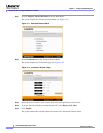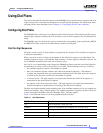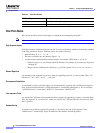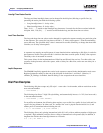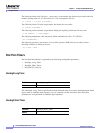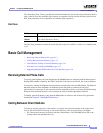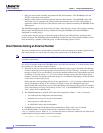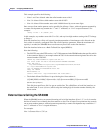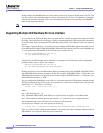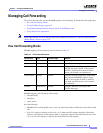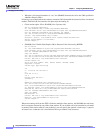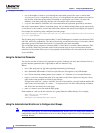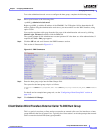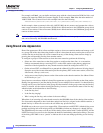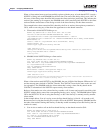
4-16
Linksys SPA9000 Administrator Guide
Document Version 3.01
Chapter 4 Configuring SPA9000 Features
Basic Call Management
In this example, the SPA9000 alerts all client stations with a four-digit user ID that starts with 531, and
also the internal Auto-Attendant when it receives an incoming call on Line 1. Furthermore, if multiple
contacts are currently registered with a user-id matching the <Contact List> parameter, the SPA9000
alerts all the registered contacts.
Note The SPA9000 alerts all registered client stations if <Contact List> = *.
Supporting Multiple DID Numbers Per Line Interface
It is possible for the ITSP to identify the local client stations to which an external incoming call should
be routed. This can be done in several ways. Linksys recommends that the ITSP indicate this information
in the TO header of the incoming INVITE while the request-URI is still addressed to the line interface
user-id.
For example, suppose the Line 1 account has the main number 4085553000, which comes with a block
of ten DID numbers: 4085553000–4084443009. When the ITSP sends the INVITE to the SPA9000 Line
1, it can indicate the DID number in the TO header user-id field, such as:
INVITE sip:4089993000@itsp1.com SIP/2.0
To: <sip:4089993003@itsp1.com>
…
Alternatively, the DID number can be indicated as a parameter in the TO header with a configurable
parameter name, such as “didn”. For example:
INVITE sip:4089993000@itsp1.com SIP/2.0
To: <sip:4089993000@itsp1.com>;didn=4089993003
…
Identify the field to use for the DID number and the parameter name in the SPA9000 <SIP DIDN Field>
and <SIP DIDN Param Name> parameters. In the first example, <SIP DIDN Field> = “TO UserId” and
<SIP DIDN Param Name> are ignored; in the second example, <SIP DIDN Field> = “TO Param” and
<SIP DIDN Param Name> = “didn.”
You can configure the SPA9000 to route calls to a client station based on DID numbers embedded in the
INVITE message by using the full syntax of <Contact List>, which allows multiple rules with each rule
separated by a “|”. The syntax is as follows:
<Contact List> = rule[|rule[|rule[...]]]
where:
rule = [did:]ext[,ext[,ext[…]]]
did = Embedded DID number. If the DID is not specified, the rule applies to any DID number
ext = Client extension number pattern; may contain * or ? wildcard or %xx escaped characters
The maximum length of the <Contact List> parameter is 383 characters.
For the previous example, you could specify the following:
<Contact List> = 4089993000:aa|4089993001:3001|4089993002:3002|…|4089993009:3009
Thus, any external caller calling the main number is answered by the Auto-Attendant, while the other 9
DID numbers are assigned to dedicated private extensions.



